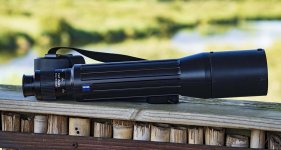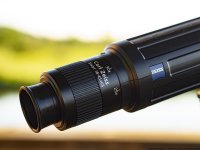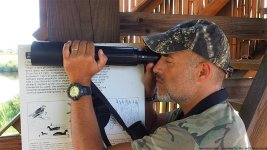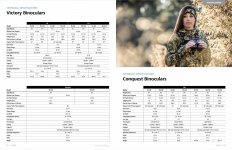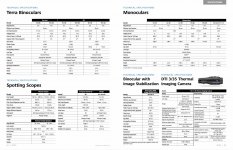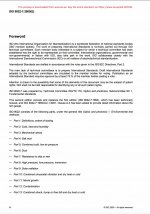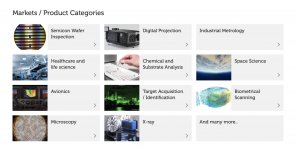On the Binomania site, Piergiovanni has also included an extensive written description of his impressions (see the link in the original post).
As it will be of interest to some, I've put it through Google Translate and applied some minor adjustments and formatting . . .
Video Review Zeiss Dialyt 18-45x65
August 6, 2021 by
Piergiovanni Salimbeni
Within Binomania.it and on the YouTube channel I have often described the performance of classic spotting scopes for naturalistic and hunting use. This time, however, I would like to tell you about a very specialised product that has three enviable strengths: robustness, lightness and speed of use. Such an instrument can easily be defined as a "field spotter" or field telescope.
I'm talking about the Zeiss Dialyt 18-45x65 which was kindly provided to me by
Bignami, official distributor of Zeiss products here in Italy. Many hunters have enjoyed its performance for some time, however, I have noticed how easily it is usable in other areas. It costs 1599 Euros and benefits from a two-year warranty, extendable to three.
MECHANICS AND FOCUSING SYSTEM
I start by confirming that the Dialyt is light, despite having a zoom eyepiece, it weighs, in fact, 1230 grams [ just over 43 oz ] which are distributed over just under 40 cm [ around 16” ]. It is very sturdy, it is the classic product that could fall from your backpack or tripod without arousing major worries.
I know many enthusiasts who avoid using their famous spotting scope in the rain or in places where it is easy to fall, just to avoid damaging it. The Zeiss Dialyt 18-45x65, on the other hand, is a tank or if you prefer a submarine; even the caps protecting the optical components are designed to withstand shocks. I believe that the classicism of design is the formula for this success. The armour is also thick in the lens area, the entire optical hull is completely wrapped in it. It is also filled with nitrogen and waterproofed up to 400 mbar.
The focusing system takes place by rotating the 65 mm diameter lens bell. I have estimated a minimum focusing distance of about ten meters [ 33 ft ]. From this position it is necessary to rotate the objective a little more than one and a half turns (counter-clockwise) to reach infinity. From 30 to 35 meters, less than half a turn is enough to observe at a long distance. The rotating movement is precise and some force must be applied. This is perfect for not accidentally losing focus.
Thanks to the good depth of field available at 18x it is perfect for various types of observation on medium-long distance subjects. I have ascertained that thanks to the visual accommodation I have an excellent perception of the depth of field between 50 meters and 150 meters, the distances at which I usually observe wild boar, deer and roe deer. In any case, if the optical theory is not an opinion at 18x from 324 (double the magnification) to infinity, everything will be in focus [ this sentence seems to have lost meaning in translation ].
In summary, as regards its construction, if I had to define it with three simple adjectives, I would say: minimalist, robust and reliable.
OPTICS
OBJECTIVE
The optics of the Zeiss Dialyt 18-45x65 are Made in Japan, consisting of five high-quality achromatic elements and a Schmidt / Pechan roof prism with T * treatment, with transmission values up to 85% of the optical system total.
The sharpness and contrast are excellent, in fact, even if it is not an apochromatic lens and you notice a little residual chromatism, the difference with cheap products is evident by increasing the magnifications. The Dialyt, in fact, remains sharp and contrasted even at 45x.
EYEPIECE
A respectable compact field scope must have a zoom eyepiece to be able to adapt to the multiple needs of an outing, be it hunting or simply naturalistic. The eyepiece provides an excursion range between 18x and 45x, therefore with a multiplication factor of 2.5x. The exit pupil is between 3.6 - 1.4 mm while the linear field at 1000 m is enclosed between 40m and 23m.
You will therefore understand that at low magnifications the pupil is pleasantly bright for most observations but that it is not possible to take advantage of a very wide-angle apparent field (just over 41 degrees). At 45x, however, it provides almost 60 degrees of apparent field.
A praise to the eyecup; very comfortable which is also retractable to facilitate use with glasses and moreover it is able to protect the field lens very well from accidental falls. You will have to find the right feeling to avoid a bit of a blackout effect at low magnification which in my case has disappeared, resting the eyebrow arch on the upper edge of the rubber.
COATINGS
The Zeiss Dialyt 18-45x65 is also optimised with the well-known Zeiss T * treatment which allows a significant increase in contrast compared to decidedly cheaper field scopes. Nothing to complain, in short, and I can only praise it.
ABERRATIONS
I will not be very detailed because being equipped with a zoom eyepiece the performance varies with the magnification.
CHROMATIC ABERRATION IN THE CENTRE OF THE FIELD
At low magnifications it is very well contained, similar to many products defined as HD or semi APO; it is perceived, sometimes, but not always, at high magnifications on backlit subjects.
LATERAL CHROMATIC ABERRATION
Also in this case, it varies according to the magnification and lighting conditions. On average, it is present at the extreme edges of the field as a faint violet green halo that is not very perceptible.
FIELD CURVATURE
Thanks to the modest field of view at low magnification, there is not much curvature of the field. It is fussy to check the loss of resolving power at the edges, so much so that by bringing the details of a deer from the centre to the edge, the image is always very legible. The situation improves already at 30x up to the maximum magnification, where the curvature of the field is very well corrected.
ANGULAR DISTORTION
It is present in the pincushion and obviously shows much more at low magnifications. It is a telescope created to “brush left and right” in search of animals or other details, I personally appreciated it very much, I believe that it provides a natural and not tiring image.
OTHER ABERRATIONS
It is not an astronomical telescope but I know some enthusiasts who often point it towards the sky, especially when they are in the high mountains, so I could not avoid testing it on the stars. I deduced, therefore, that at 18x starting from about 75% there is a bit of coma and astigmatism which decreases at high magnifications, where it is present, almost at the edge.
USE IN THE FIELD
I will not be prolix. With the Zeiss Dialyt 18-45x65 you can forget: heavy backpacks, sturdy tripods, fixed eyepieces of various focal lengths and focusing problems. It is minimalist but well built.
Thanks to the rotation of the cell that contains the objective, it is possible to be very precise even with winter gloves, an operation that is often not feasible with compact spotting scopes equipped with the classic focus near the eyepiece.
The sharpness and contrast are at the highest levels, the magnification range is perfect for all kinds of daytime observation and at dusk at 18x it always shows various details.
I appreciated this concept of Zeiss Dialyt, which in astronomy is defined as "grab and go", or "get to go”. In fact I made some outings without even feeling the need to use a tripod, as in this case. It was enough for me to place it on a cushion filled with sand, over the car window, press it against the trunk of a tree or on the parapet of the roof terrace. In some cases it would also be possible to choose a dry branch found directly in the field and set up a very quick support with a small knife.
At 18x with a little practice, you can do some panning, preferably seated using your elbows for support.
It can be easily stored in a backpack together with dozens of other accessories and they could also make you make some short astronomical observations, since at the maximum magnifications the lunar craters are clearly visible, as well as the brightest galaxies.
The straight view is also useful for various types of observation, especially when observing, for example, from a height or from a lookout tower, as in my case.
PLUSES AND MINUSES
PLUSES
• Robust and reliable
• Precise focus
• Perfect magnification range
• Zeiss T multi-layer treatment
• It does not require very sturdy tripods
• It can be transported anytime, anywhere
MINUSES
• For purists the optics are not apochromatic so expect some chromatic aberration
• At low magnification the apparent field of view is narrow
IN SUMMARY
I believe that the Zeiss Dialyt 18-45x65 is a minimalist, essential, robust and performing product able to satisfy both the most demanding hunter and the hiker who needs high magnifications but has to deal with the overall dimensions. It is a field scope designed and built to last a lifetime.
If you love this kind of quality, this is the right product for you.
PRICE
The Zeiss Dialyt 18-45x65 costs 1599 Euros and benefits from a three-year warranty.
THANKS
As always, I thank Andy de Santis from Bignami for providing the specimen subject of this test and for allowing us to scramble it a bit.






